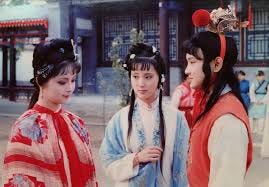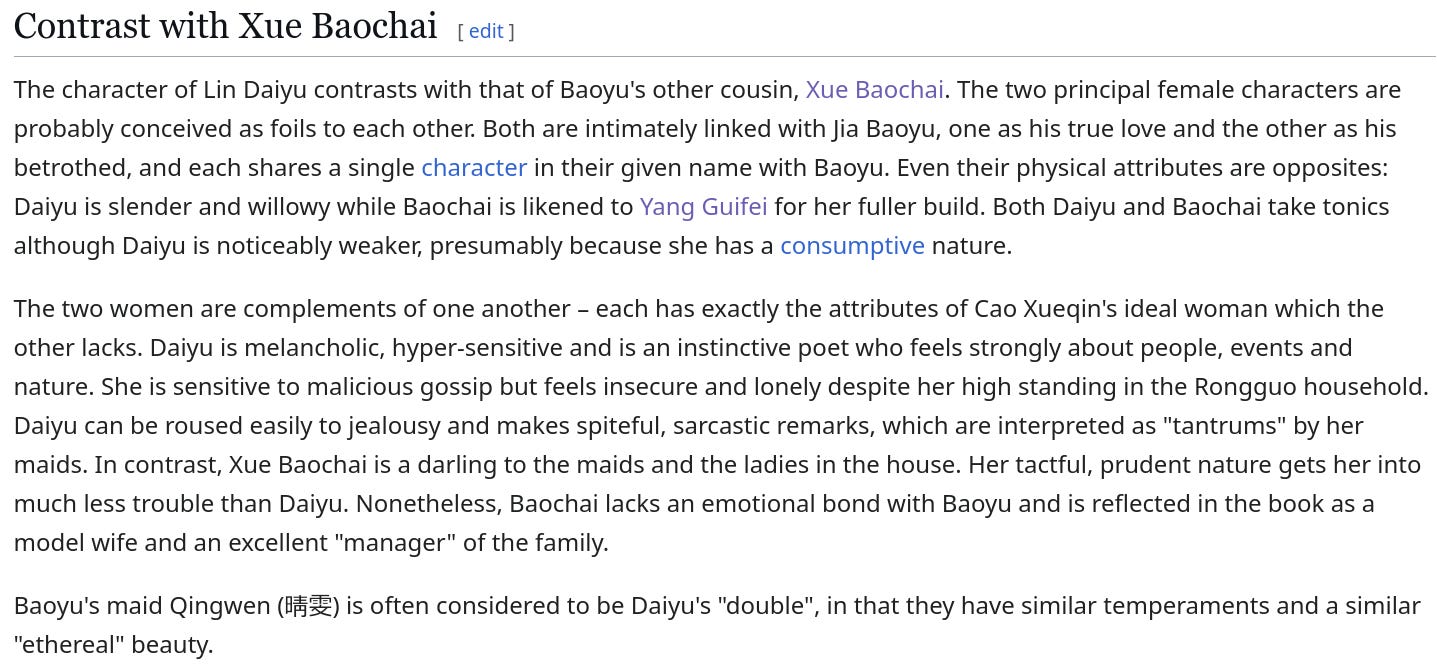David Hawkes on Two-In-One
Yesterday we briefly met a spiritual character named Jianmei:
再將吾妹一人,乳名兼美,表字可卿者,許配與汝。
And now I’ll give you this younger sister of mine. Her childhood name is Jianmei, and her formal name is Keqing. Tonight, in this perfect hour, you may consummate the marriage.
We saw earlier that this Jianmei combined the best features of Lin Daiyu and Xue Baochai into one:
更可駭者,早有一位仙姬在內,其鮮豔嫵媚,大似寶釵,嫋娜風流,又如黛玉。
But the most frightening thing was the celestial girl who was waiting in the room. Her charm and beauty was a lot like Xue Baochai, and her elegant and spirited nature was a lot like Lin Daiyu.
So what’s going on here?
Well, David Hawkes believed that this was a sign that Xue Baochai and Lin Daiyu were the “perfect woman” divided into half:

Unfortunately, this seems to be the only place where David Hawkes describes this particular theory. However, this theory has been somewhat canonized on Wikipedia’s Lin Daiyu page:
The problem, however, is that this is not necessarily true. It’s not necessarily the case that Lin Daiyu and Xue Baochai were conceived to be “the perfect woman” divided into two, nor is it likely true that the characters were designed to be foils of each other.
In fact, as we’ve already seen, Lin Daiyu’s most obvious foil is Wang Xifeng, not Xue Baochai.
Think about it. Wang Xifeng is decidedly practical. She worries about finances (and, as we’ll eventually see, is more than happy to skim some money off for her own interests). Lin Daiyu’s head is always in the clouds, and is more focused on poetry and artistic self-expression than on anything even remotely practical.
Lin Daiyu is reserved and careful, while Wang Xifeng is boisterious and assertive.
Xue Baochai, meanwhile, seems to represent the Confucian ideal of feminine beauty. We’ll gradually see in this translation how Xue Baochai’s response to difficulties and challenges involves saving face and understanding the correct heirarchical roles involved.
Lin Daiyu can be thought of as representing a Daoist ideal, though I’d say that even this definition can be somewhat problematic.
However, I do believe that it’s correct to think of Jia Baoyu’s love conflict as a symbol of his philosophical hesitation between his duty (acting as the filial son and the rightful heir, or the Confucian way of thinking) and his heart (an unfettered emotional [情] life with Lin Daiyu, the woman he actually loves). Jia Baoyu seems to be forever caught between what his mind tells him he should do and what his heart tells him he wants to do.
In my mind, that’s the right way to understand the dichotomy between Lin Daiyu and Xue Baochai. It’s not that the two add together to form Cao Xueqin’s perfect woman. Rather, the two characters represent Jia Baoyu’s internal conflict — and yet they are absolutely real characters in the end, not caricatures or stereotypes.
A few weeks ago I created a video on Dream of the Red Chamber’s lack of stereotypical characters:
The video wasn’t all that well viewed (and I’m not surprised, honestly). However, I do want to point out something that I inadvertently hid in that video.
Dream of the Red Chamber is very much a romance novel. However, it’s a romance novel in the old 18th century style of Chinese romantic fiction. This was known as 才子佳人 at the time; in fact, you can read a very well written Wikipedia article all about it.
Now, if you read the article carefully, you’ll realize that Dream of the Red Chamber absolutely fits this old version of Chinese romance. In fact, the characteristics fit that literary style so well that it simply cannot be a coincidence. A few examples:
There is a love story between a beautiful girl and a handsome scholar. There’s no doubt that Jia Baoyu as depicted in the novel is handsome, though he is a bit immature. Lin Daiyu is drop-dead gorgeous, and Xue Baochai is also extremely attractive. In fact, I don’t think there’s a single female character in the book who isn’t described as being beautiful.
The families of the lovers are socially distinguished. There’s no doubt that the Jia family is distinguished, though its fortunes are on the verge of collapse. Xue Baochai’s family is also clearly socially distinguished, to the point where her brother used his connections to essentially get away with murder. Lin Daiyu’s father, Lin Ruhai, doesn’t seem to be quite as well socially connected, though he certainly was connected enough to marry a girl from the prestigious Jia family.
The protagonists have an aptitude for poetry and prose. We haven’t seen many examples of this yet, but we will soon. Jia Baoyu’s poetry is excellent. Xue Baochai is a master of the written word. And Lin Daiyu’s poetry might be the best in all of Chinese fiction.
The protagonists have deceased parents. This is true of both Lin Daiyu and Xue Baochai. As the Wikipedia page correctly notes, this was likely a trope at the time in order to make arranging marriages a bit easier on the authors.
The story starts with an unexpected meeting between the lovers. We didn’t see much of a meeting between Jia Baoyu and Xue Baochai, but we did see a meeting between Jia Baoyu and Lin Daiyu in chapter 3. And, in chapter 1, we absolutely did see the interesting romantic connection between the stone and the fairy plant, a meeting that was also unexpected and unplanned.
The woman has a discerning female servant who acts as a matchmaker and mediator between the two lovers. We’re several chapters away from seeing this, but this is also absolutely the case in Dream of the Red Chamber. In fact, David Hawkes notes a few times in his pages of introductory notes and appendicies that the maids often reflect the personalities of the characters they serve. This isn’t a Dream of the Red Chamber invention, but, rather, is another trope of 才子佳人 fiction.
There are obstacles to the marriage. We’ll see this as the story unfolds. Of course, there have to be obstacles. Nobody wants to read a romance book where nothing goes wrong.
However, there is a major difference between Dream of the Red Chamber and the 才子佳人 novels:
There is no happy ending. As is the case in modern romance, so it was in 18th century Chinese romance. You needed to have a happy ending. Usually this consisted of the male protagonist finally passing the imperial examinations, winning the respect of his bride-to-be’s parents, and getting the girl in the end.
Now, if you go back and read through the chapter 5 poems carefully, you’ll notice that they are all pessimistic and quite dark. This is also done on purpose, and is a stark contrast to the 才子佳人 genre of fiction.
The Wikipedia page I linked to above noted that Dream of the Red Chamber was critical of the 才子佳人 genre. However, what the authors of that page have neglected to discover is that Dream of the Red Chamber is very heavily based on the 才子佳人 genre. Actually, the fact that Dream of the Red Chamber does not have a happy ending was hugely controversial in its time, and eventually gave way to a myriad of potential alternative endings to the book — as well as to the endless debates of Redology about which passages are authentically from Cao Xueqin and which are by the “rascal” Gao E.
Personally, I think Dream of the Red Chamber is extremely misunderstood, even by Chinese scholars. It needs to be understood in the literary context of its day. The genius in the novel is the way that it bends the expectations of its readers, and in the social criticism that it delivers without sermonizing.
The character Jianmei (兼美), who only makes this brief appearance in Jia Baoyu’s dream, does not exist to tell the reader that Lin Daiyu and Xue Baochai are two halves of a mythical “perfect woman.” Instead, she serves as a symbol of Jia Baoyu’s internal conflict: his desire to both perform his duty and follow his heart. David Hawkes is wrong.






Good points. I agree "the two characters represent Jia Baoyu's [or the author's] internal conflict".
In Hawkes' defense, though, he does preface his remarks with the caveat: "From various hints in the commentary, we can deduce...". Looking at the commentary in the 甲戌 edition (manuscript from 1754), on the passage where the character 兼美 appears, there's a suggestion it refers to Xue and Lin ("蓋指薛林而言也").
Another comment, in the 庚辰 edition (manuscript from c. 1761), states that Baochai and Daiyu are the same person ("釵玉名雖兩個,人卻一身,此幻筆也").
So one could argue that the two characters also represent internal conflicts within the same girl. (I suspect this world turns many Daiyus into Baochais.)
Your line that "Lin Daiyu is drop-dead gorgeous, and Xue Baochai is also extremely attractive" was amusing, and oddly enough reminded me of the Chinese woman writer Eileen Chang. If I recall correctly, she could tell the last 40 chapters of the Dream of the Red Chamber were not written by Cao Xueqin in part because they contain physical descriptions of Daiyu, whereas the first 80 chapters do not. For Chang, Baochai was worldly; Daiyu, otherworldly.
This aligns with the contemporary literary critic Liu Zaifu's view of Daiyu as a goddess, leading Baoyu forward in the novel "like Dante's guide Beatrice". Below is a pertinent comment by Liu, taken from his beautiful "Reflections on Dream of the Red Chamber". Hope you enjoy it.
"Lin Daiyu and Xue Baochai are both very pretty. But, behind Xue Baochai's calm appearance the dust of the mundane world floats in her mind. She is capable of conforming to the conventions of the mundane world, but incapable of feeling deep sorrow, let alone experiencing lingering sadness. So, she lives rather comfortably. Lin Daiyu's mind is pure and clean, just like her tears. She is unable to get along with the mundane world, and, at the same time, the filth of the mundane world cannot enter her mind. As she immerses herself in sadness and keeps her soul pure, she displays a kind of uncontaminated beauty that is lacking in Xue Baochai. Unfortunately, the cruel rules of the mundane world only assure the survival of those who adapt themselves. In the end she could not survive and could not even find a place for her poems."
Apologies for the lengthy comment.